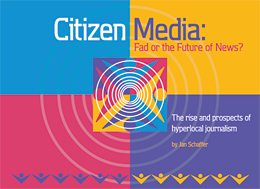The rise and prospects of hyperlocal journalism

Introduction
By Jan Schaffer,
J-Lab Executive Director
J-Lab has been funding citizen media start-ups with micro-grants for two years now. We’ve seen how quickly committed founders can build momentum and gain traction in their communities. The findings in this report were less of a surprise and more of an affirmation of what we had started to see.
We agree with 98% of the respondents in our web survey who said that the emergence of local news web sites with content built from community members is “a good thing” – although it may not all be “journalism,” the kinds of finished stories you see in a newspaper. Because of that, we prefer the term “citizen media,” although we use that term interchangeably with “citizen journalism” in this report. Over 79% of the respondents to our web survey considered the information on their sites to be “journalism.”
This report focuses specifically on micro-local community news sites that contain content generated by users. When we started this research in the spring of 2006, we were able to identify about 500 citizen media sites. As we issue this report, we have been able to identify several hundred more and will soon catalogue them on a new web site, the Knight Citizen News Network (www.kcnn.org), supported by the Knight Foundation.
More impressive than the numbers, though, is the impact these sites are having on their communities. With limited readership and very little revenue, 73% of those who responded pronounced their sites to be a “success.’’ Why? Because they have watchdogged local government, provided news that couldn’t otherwise be had, nudged local media to improve, helped their community solve problems, even, to a degree, increased voter turnout and the number of candidates running for office.
This study takes an early snapshot of a very robust development. We interviewed 31 site operators in-depth, and we fielded a 60-question online survey. Not all 191 respondents could, or did, answer every question, but they poured out their hearts in open-ended responses. Their resolve to continue, often on their own dimes, was palpable.
- Citizen media is emerging as a form of bridge media, linking traditional media with forms of civic participation.
- No one size fits all; there are many models.
- Instead of being comprehensive sources of news, sites are forming as fusions of news and schmooze.
- Most citizen sites don’t use traditional metrics – unique visitors, page views or revenues – to measure their success.
- Success is often defined as impact on their community.
- Half of our respondents said their sites don’t need to make money to continue.
- Yet there are new kinds of media companies starting to emerge.
- There is a high degree of optimism that citizen news sites are here to stay.
- Finding ways to attract more contributors and some operating support are major challenges.
We think citizen media sites will become an enduring part of the emerging newscape. While we think many individual sites will collapse as their founders burn out, others will arise to take their place.
With this study, we urge those who can help build capacity in this arena to pay attention. Legacy media companies: Think about partnering – and even supporting – successful sites, not competing with them. Journalism schools: Pursue the possibilities of citizen media sites as learning laboratories. Community foundations: Be alert to real possibilities for building community capacity.
Our deep thanks to the Ford Foundation and to former program director Jon Funabiki, whose curiosity launched this project. Please read on …
Jan Schaffer,
J-Lab Executive Director
February 2007
Table of Contents
Chapter 1: The Big Picture
- Chapter Introduction
- About the Study
- Hyperlocal Diversity
- Defining Citizen Media
- Common Characteristics
- Having Impact
Chapter 2: Mapping Citizen Media Models
- Chapter Introduction
- Community Cooperatives
- Trained Citizen Journalist Sites
- Professional Journalist Non-profit Sites
- Professional Journalist For-profit Sites
- Blog Aggregator Sites
- Syndicated Multi-site Models
- Legacy Media Sites
- Solo Enterprise Non-profit Sites
- Solo Enterprise For-profit Sites
Chapter 3: Creating Content
- Chapter Introduction
- To Edit or Not
- Mission Statements
- Getting Back What You Put Out
- Reverse Publishing: From Web to Print
Chapter 4: Building Interest
Chapter 5: Making Money
- Chapter Introduction
- Bluffton Today
- Wicked Local
- New West
- Village Soup
- Backfence
- Baristanet
- Voice of San Diego
